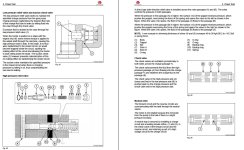Nacademus, what you describe IS too aggressive with scarifiers. Don't use the same angle when using just the back blade as with the scarifiers. Lengthen the top link when using the scarifiers. When they bite in, they will pull the boxblade into the dirt. There is enough pressure that it will cause the weight transfer (think of a weight distribution hitch) to clamp down on the rear wheels, stopping them dead. The angle of the scarifiers is important. The boxblade can be "tuned" so that scarfiers pull the unit into the material, so no additional weight is needed, but still not enough to bring the tractor to a stop. Been there, done that.
Honestly. That makes sense now that you explain it that way-wonderful analogy. In my head, I didn't consider that the 3PT was rigid in position with the lever untouched and only freely travels upward.
The weight distribution hitch analogy is a good one.
What is odd, though, was that these scarifiers are not adjustable and really only contact about an inch, inch and a half BARELY into the soil. I could still almost see the each whole scarifier tooth as it wasn't fully bit in the dirt that much. The box was nowhere near full. It's weird. I should have taken a picture-if I did, I bet most of you would be surprised. Oh, and there are only THREE scarifiers on my BB. Maybe the rear blade hung up on something I just didn't see.
King Kutter 4 ft Box Blade BB 48 XB �
I still think it if it was actually hooked and stopped cold, it should have kept eating, digging in. Just sort of petered out on me.
There MUST have been some sort of force, like you said comparing its operation like a WD hitch. I just couldn't identify it at the time.
I built my own hydraulic pressure gauge from parts on Amazon-just haven't gotten around to using it. I will warm the tractor up tonight and check it.
Here is what I used to make my own hydraulic gauge-in case anyone else wants to make one and save some money.
Hydraulic Liquid Filled Pressure Gauge 0-3000 PSI
https://www.amazon.com/gp/product/B019465ZC8/ref=ppx_yo_dt_b_asin_title_o00_s00?ie=UTF8&psc=1
$10
3/8" NPT Thread Hydraulic Coupler Set ISO 7241-B (Coupler set with dust caps-assure your tractor has 3/8 or not and get what fits)
https://www.amazon.com/gp/product/B07FVLY3BQ/ref=ppx_yo_dt_b_search_asin_title?ie=UTF8&psc=1
$19-but a single male can be found for $10
I sourced a small 3/8" to 1/4" npt adapter from a local store (Rural King) ~$5
My total investment was about $35 but could be done for $10 less. I wanted to keep the other coupler in the set as a spare, anyways.
I like to try and make my own things when I can. Gives me a little project and something to look forward to in the mail . ^_^

